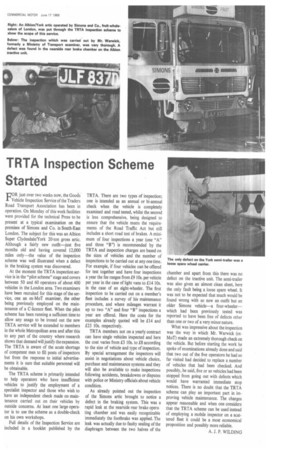TRTA Inspection Scheme Started
Page 65

If you've noticed an error in this article please click here to report it so we can fix it.
R just over two weeks now, the Goods Vehicle Inspection Service of the Traders Road Transport Association has been in operation. On Monday of this week facilities were provided for the technical Press to be present at a typical examination on the premises of Simons and Co. in South-East London. The subject for this was an Albion Super Clydesdale/York 20-ton gross artic. Although a fairly new outfit—just five months old and having covered 12,000 miles only—the value of the inspection scheme was well illustrated when a defect in the braking system was discovered.
At the moment the TRTA inspection service is in the "pilot scheme" stage and covers between 50 and 60 operators of about 400 vehicles in the London area. Two examiners have been recruited for this stage of the service, one an ex-MoT examiner, the other being previously employed on the maintenance of a C-licence fleet. When the pilot scheme has been running a sufficient time to allow any snags to be ironed out the new TRTA service will be extended to members in the whole Metropolitan area and after this to any part of the country where research shows that demand will justify the expansion. The TRTA is aware of the acute shortage of competent men to fill posts of inspectors but from the response to initial advertisements it is sure that suitable personnel will be obtainable.
The TRTA scheme is primarily intended to help operators who have insufficient vehicles to justify the employment of a specialist inspector and those who wish to have an independent check made on maintenance carried out on their vehicles by outside concerns. At least one large operator is to use the scheme as a double-check on his own workshops.
Full details of the Inspection Service are included in a booklet published by the TRTA. There are two types of inspection; one is intended as an annual or bi-annual check when the vehicle is completely examined and road tested, whilst the second is less comprehensive, being designed to ensure that the vehicle meets the requirements of the Road Traffic Act but still includes a short road test of brakes. A minimum of four inspections a year (one "A" and three "B") is recommended by the TRTA and inspection charges are based on the sizes of vehicles and the number of inspections to be carried out at any one time. For example, if four vehicles can be offered for test together and have four inspections a year the fee ranges from £9 10s. per vehicle per year in the case of light vans to £14 10s. in the case of an eight-wheeler. The first inspection to be carried out on a member's fleet includes a survey of his maintenance procedure, and where mileages warrant it up to two "A" and four "B" inspections a year are offered. Here the costs for the examples already quoted will be £14 and £23 10s. respectively.
TRTA members not on a yearly contract can have single vehicles inspected and here the cost varies from £3 10s. to .£8 according to the size of vehicle and type of inspection. By special arrangement the inspectors will assist in negotiations about vehicle choice, purchase and maintenance systems and they will also be available to make inspections following accidents, breakdowns or disputes with police or Ministry officials about vehicle condition.
As already pointed out the inspection of the Simons artic brought to notice a defect in the braking system. This was a rapid leak at the nearside rear brake operating chamber and was easily recognizable immediately the footbrake was applied. The leak was actually due to faulty sealing of the diaphragm between the two halves of the chamber and apart from this there was no defect on the tractive unit. The semi-trailer was also given an almost clean sheet, here the only fault being a loose spare wheel. It was not to be expected that much would be found wrong with so new an outfit but an older Simons vehicle—a four-wheelerwhich had been previously tested was reported to have been free of defects other than one or two of a very minor nature.
What was impressive about the inspection was the way in which Mr. Warwick (exMoT) made an extremely thorough check on the vehicle. But before starting the work he spoke of examinations already done and said that two out of the five operators he had so far visited had decided to replace a number of vehicles that had been checked. And possibly, he said, five or so vehicles had been stopped from going out with defects which would have warranted immediate stop notices. There is no doubt that the TRTA scheme can play an important part in improving vehicle maintenance. The charges appear reasonable and when one considers that the TRTA scheme can be used instead of employing a mobile inspector on a scattered fleet it could be a most economical proposition and possibly more reliable.




















































































































































